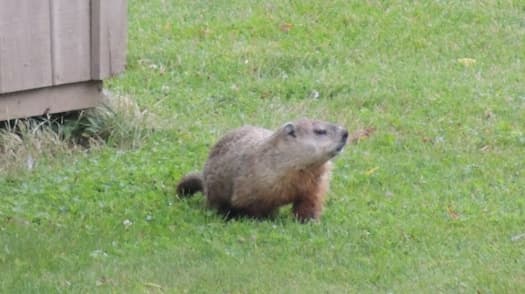Groundhog Control

Groundhog Control Methods
While they are considered “shy”, you can find Groundhogs almost anywhere. They are frequently seen in the morning along roadsides, and in fields along the edge of forests as they search for their morning meal. Also called woodchucks, they can be a big problem in both the home garden and commercial farms. The groundhog’s diet consists of vegetation. They love many of the vegetables that you grow in your vegetable garden. They have very big appetites. Fortunately, there are a few groundhog control methods that should eliminate the problem.
Controlling woodchucks can be problematic. Fortunately, they can’t fly, and they can’t climb tall fences. However, they are persistent. They tirelessly dig under garden fences. If you plug up a hole one day, the very next day they are busy digging under the fence in another spot. Woodchucks just don’t give up.
We offer below, several ways to control groundhogs or eliminate them from your vegetable garden.
The World's Most Famous Groundhog

Why that’s none other than Punxsutawney Phil. Phil comes out of his burrow on Groundhog Day, February 2, and predicts how much longer winter will last. According to legend, if this sleepy fellow sees his shadow, there will be six more weeks of winter. If not, spring weather will soon arrive. More on Punxsutawney Phil and Groundhog Day.
Did You Know? Woodchucks are members of the rodent family.
Groundhog Control - Understanding Their Lifestyle and Habit
Understanding a woodchuck’s lifestyle, habits, and diet is very helpful in controlling them.
They live in burrows that are usually dozens of feet long and have multiple chambers(mounds). They have a summer home (burrow) and a winter one. There are at least two openings. The main entrance is one entryway, and an escape hole or spy-hole is the other. Sometimes there is a third. The summer home of a groundhog will sometimes be under a shed. This author has experienced one under the shed. Obviously, it is not a pleasant experience.
In their winter burrow, Groundhogs live from fall to spring. They hibernate all winter, eat underground with stored food, and mate in this burrow. After spring arrives, female groundhogs emerge with their offspring. Groundhogs are loners. By late spring, adult males, adult females, and offspring will all be on their own.
Groundhogs are herbivores. They like almost all vegetables in your vegetable garden and many herbs, too. Groundhogs eat all parts of plants. In addition to vegetables, they also like fruits, including apples and pears, Watermelons are a favorite meal. They will also eat nuts.
If that’s not enough, groundhogs will also eat some flowers. These include:
Asters
Daises
Delphinium
Lilies
Marigolds
Pansies
Phlox
Sunflowers
Snapdragons
Sweet peas
Groundhogs are shy creatures. They are very motion-sensitive and have good hearing. If they hear or see you, even from quite a distance, they run to the safety of their burrow.
Groundhog Control Methods
Here are our Woodchuck control suggestions:
1. Trapping: Hav-a-hart traps are an effective means of ridding your area of woodchucks. They can be shy. So, it may take a while to enter the trap. Once they are trapped many towns will take them away.
Best bait: A slice of bread with peanut butter, fresh watermelon, and apple slices.
Important: Check local laws before trapping animal pests. They might not allow you to transfer and release an animal into another area. Contact your local animal control department for local rules.
2. Smelly Repellents and Pepper Spray: Groundhogs do not like offensive odors. Caution: Spraying vegetables may render them undesirable to you, too. Apply every one to two weeks and after a rain.
Find a quick and easy Pepper spray recipe
3. Epsom Salts – Groundhogs do not like the taste. Apply to the plants. In addition, there is fertilizer value to Epsom salts. Apply every one to two weeks and after a rain.
4. Fences and screens: These have some effectiveness. The fencing must be metal. Groundhogs effortlessly chew through plastic netting. Groundhogs can dig under the fence. Be vigilant for signs of digging. They have been known to climb over low fences.
5. Hunting: If you can hunt in your area, this method works well….. if you are a good shot. Check local laws, for rules and regulations.
6. Fumigation: Shy groundhogs can readily be chased to the safety of their burrows. Once they are in their burrow, cover one hole well. Then, toss in a can of fumigant into the second hole and cover the second hole well.
7. Motion Devices: Motion devices, like pinwheels and wind chimes, really bother groundhogs. It may cause them to move on to another area.
Additional Animal and Groundhog Control Resources
Please support our site. Shop for:
- rmmatthews100@hotmail.com
- 585-721-6528
- Rochester, NY
©1999-2024 GardenersNet.Com, All Rights Reserved

